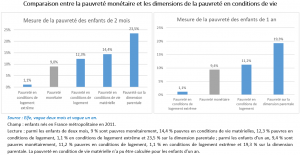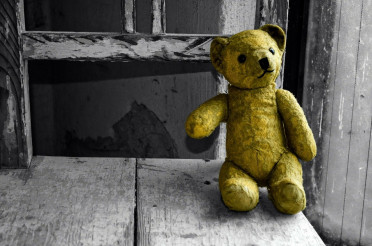Measuring young child poverty better by taking into account a wider range of living conditions criteria
Poverty among children used to be measured only monetarily, in terms of household disposable income, or in terms of household living conditions. Drawing on data from the ELFE cohort study data (French Longitudinal Study of Children), INED researchers Marion Leturcq and Lidia Panico, together with Barbara Castillo Rico, who holds a PhD in economics, have called into question how early childhood poverty is measured using new indicators that adopt the child’s perspective.
Household income is not enough to describe the experience of poverty.
There are several ways of measuring childhood poverty. Many studies calculate the proportion of children living in low-income households, usually identified as households whose standard of living is below 50% of the median. (In France INSEE evaluated the median at 1,840€ a month in 2017, meaning that half of French households were living below that monthly level). Other studies use household deprivations, ignoring the specific needs of children. In our study, four indicators were determined to measure living conditions poverty in the lives of very young children: material conditions, such as household not being able to buy new clothes, leave on vacation, or buy gifts; housing conditions such as overcrowding or heating difficulties; extreme housing conditions such as living without a toilet or hot water; and parental involvement, which refers to the quality of parent-child interactions and is measured for children two months of age as breastfeeding and extremely regular and close physical contact and for one-year-olds as parents playing with and reading stories to them.
Contrasting and complementary measures of young child poverty
According to the classic monetary poverty indicator, nearly one in ten very young children live in a poor household. But this proves a restrictive way of measuring poverty when compared to other indicators. The proportion of children 2 months of age rises to 12% when housing conditions are taken into account and to 14% when the material conditions criterion is applied. And turning to the non-material aspect of poverty, nearly one in five children aged 1 year are deprived according to the parent-child relationship quality indicator. Indicators for identifying poor households only partially overlap. For example, more than a third of 2-month-olds considered materially poor are not monetarily poor. And fewer than half of children considered poor in terms of parental involvement are monetarily poor.
Early childhood poverty: comparison of monetary poverty and poverty by living conditions criteria

Which children are most exposed to poverty?
When several indicators are taken into account we can better identify factors that expose children to a high risk of poverty. For example, living in a single-parent family is heavily correlated with material and monetary poverty, but this group is less exposed to poor living conditions. And at two months of age, the risk of children living in a single-parent family being deprived of parental involvement is relatively low. At age one, however, the opposite is true. Moreover, a young child whose parents are of immigrant background is at relatively high risk of living in poor housing conditions but relatively low risk of being deprived of parental involvement. These findings suggest that “underprivileged” groups are not homogeneous and that different groups may need different types of public policy support.
Combating childhood poverty is currently a national policy priority in France. This study highlights the necessity of establishing criteria other than household income to identify children living in difficult conditions. Implementing and measuring new indicators would help produce better adapted public policies that would more fully take into account the complexity and multidimensional nature of child poverty.
Source : Bárbara Castillo Rico, Marion Leturcq et Lidia Panico, 2020, "La pauvreté des enfants à la naissance en France. Résultats de l’enquête Elfe", Revue des politiques sociales et familiales: 35-49.
Contacts : Bárbara Castillo Rico, Marion Leturcq et Lidia Panico
Online: December 2020

